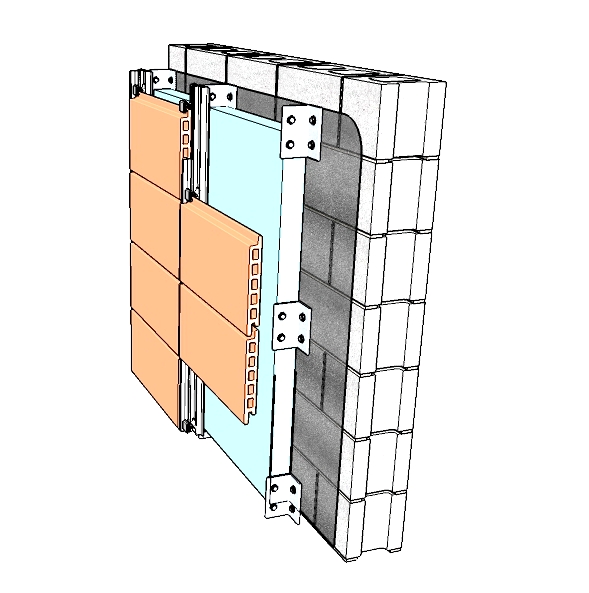Waterproofing
Waterproofing is a process that ensures a structure or object is able to keep out 100% of any water that comes into contact with it. In construction, waterproofing can increase the life of common materials like concrete, iron, paint and more. Although it is not common to refer to a building as being 'waterproof' (although it would not be wrong and would be understood by most), it is more common to use the term ‘watertight’ or 'weatherproof'.
A new building will reach a stage in construction where it is made watertight to prevent water from penetrating into internal areas. Alternatively, an existing building may undergo remedial works to make its basement watertight, to prevent penetrating damp or rising damp and so on. For more information see: Damp proofing.
However, the term waterproof can be applied to particular elements of the building fabric that are designed to keep out water. For example, although high-grade concrete can be highly impervious to moisture this is difficult to achieve in practice due to a number of construction reasons. But when PVC or copper water bars are incorporated at joints (the weak points) and a waterproofing agent is added to the mix, a waterproof construction can be achieved.
Similarly, a synthetic roofing membrane may be termed waterproof not only because water is unable to penetrate the molecular structure of the material but also because it can form a continuous, seamless roof surface that can be waterproof when properly installed.
In contrast, a slate roof may be termed watertight as it will generally do an excellent job of keeping water out. However, in severe weather conditions (such as wind driven rain) it may not be waterproof since water ingress may occur through joints. Cladding systems such as rainscreen cladding may allow water to penetrate through a first layer of defence, but this is then drained away before reaching the interior.
Cementitious waterproofing is a method of waterproofing used in wet areas like toilets and bathrooms. This is a semi-flexible or rigid type of waterproofing, and material should not be exposed to weathering or sunlight.
More flexible than cementitious waterproofing, liquid membrane waterproofing is a thin coating of primer and two top coats.The liquid cures into a rubbery coating on surfaces and can provide high elongation. The durability of the coating depends on what type of polymer is used.
[edit] Related articles on Designing Buildings Wiki
Featured articles and news
RTPI leader to become new CIOB Chief Executive Officer
Dr Victoria Hills MRTPI, FICE to take over after Caroline Gumble’s departure.
Social and affordable housing, a long term plan for delivery
The “Delivering a Decade of Renewal for Social and Affordable Housing” strategy sets out future path.
A change to adoptive architecture
Effects of global weather warming on architectural detailing, material choice and human interaction.
The proposed publicly owned and backed subsidiary of Homes England, to facilitate new homes.
How big is the problem and what can we do to mitigate the effects?
Overheating guidance and tools for building designers
A number of cool guides to help with the heat.
The UK's Modern Industrial Strategy: A 10 year plan
Previous consultation criticism, current key elements and general support with some persisting reservations.
Building Safety Regulator reforms
New roles, new staff and a new fast track service pave the way for a single construction regulator.
Architectural Technologist CPDs and Communications
CIAT CPD… and how you can do it!
Cooling centres and cool spaces
Managing extreme heat in cities by directing the public to places for heat stress relief and water sources.
Winter gardens: A brief history and warm variations
Extending the season with glass in different forms and terms.
Restoring Great Yarmouth's Winter Gardens
Transforming one of the least sustainable constructions imaginable.
Construction Skills Mission Board launch sector drive
Newly formed government and industry collaboration set strategy for recruiting an additional 100,000 construction workers a year.
New Architects Code comes into effect in September 2025
ARB Architects Code of Conduct and Practice available with ongoing consultation regarding guidance.
Welsh Skills Body (Medr) launches ambitious plan
The new skills body brings together funding and regulation of tertiary education and research for the devolved nation.
Paul Gandy FCIOB announced as next CIOB President
Former Tilbury Douglas CEO takes helm.
UK Infrastructure: A 10 Year Strategy. In brief with reactions
With the National Infrastructure and Service Transformation Authority (NISTA).
























Comments
Waterproofing is the process of making a surface or structure resistant to the penetration of water. It is commonly applied to various areas in buildings or structures to prevent water ingress, leakage, and potential damage. Waterproofing is essential in areas that are exposed to moisture, such as basements, roofs, bathrooms, balconies, and foundations.
There are different methods and materials used for waterproofing, depending on the specific requirements and the location being treated. Here are some common waterproofing techniques:
Thanks for your comment, maybe you want to create a new article covering your points above, perhaps called "common waterproffing techniques", We could then cross link it to the above. Best regards. Editor